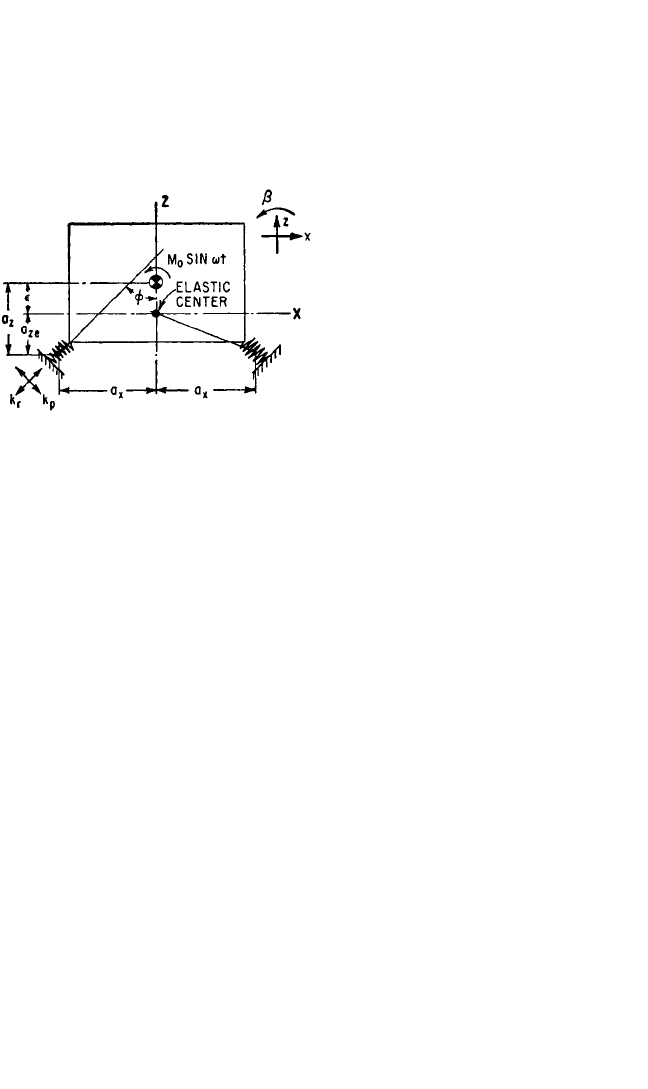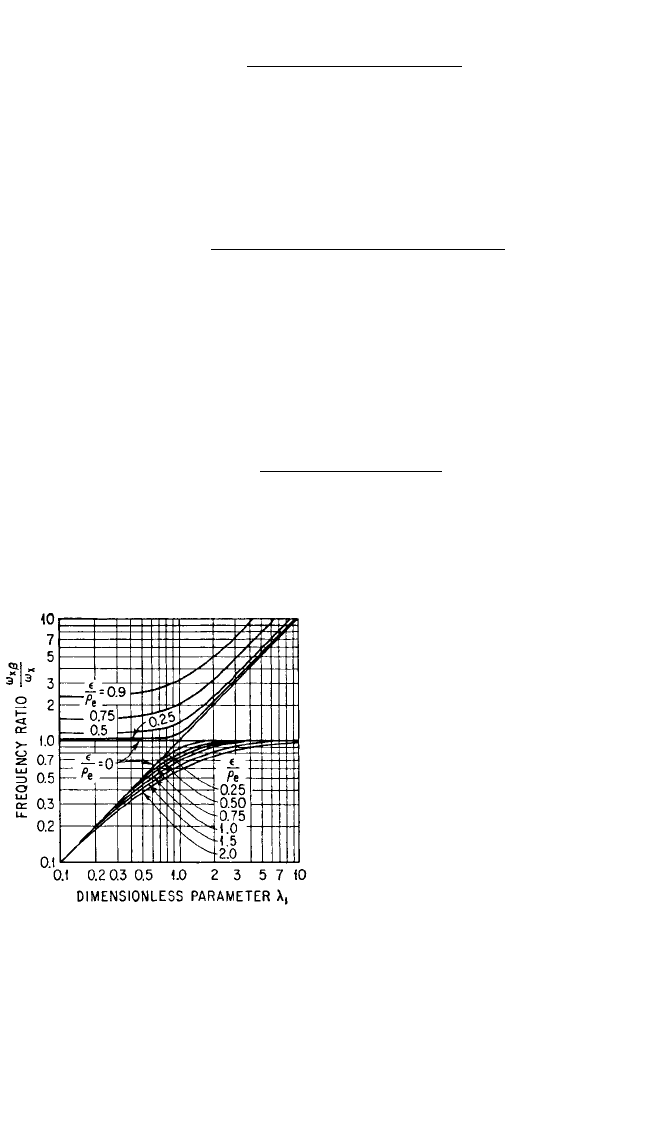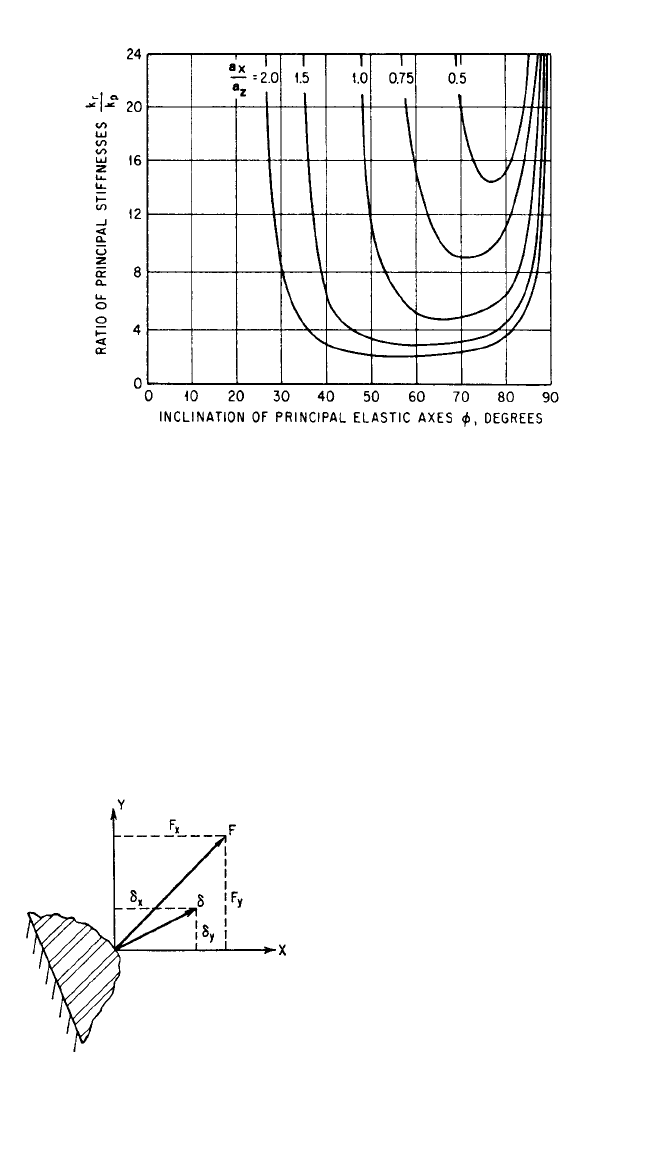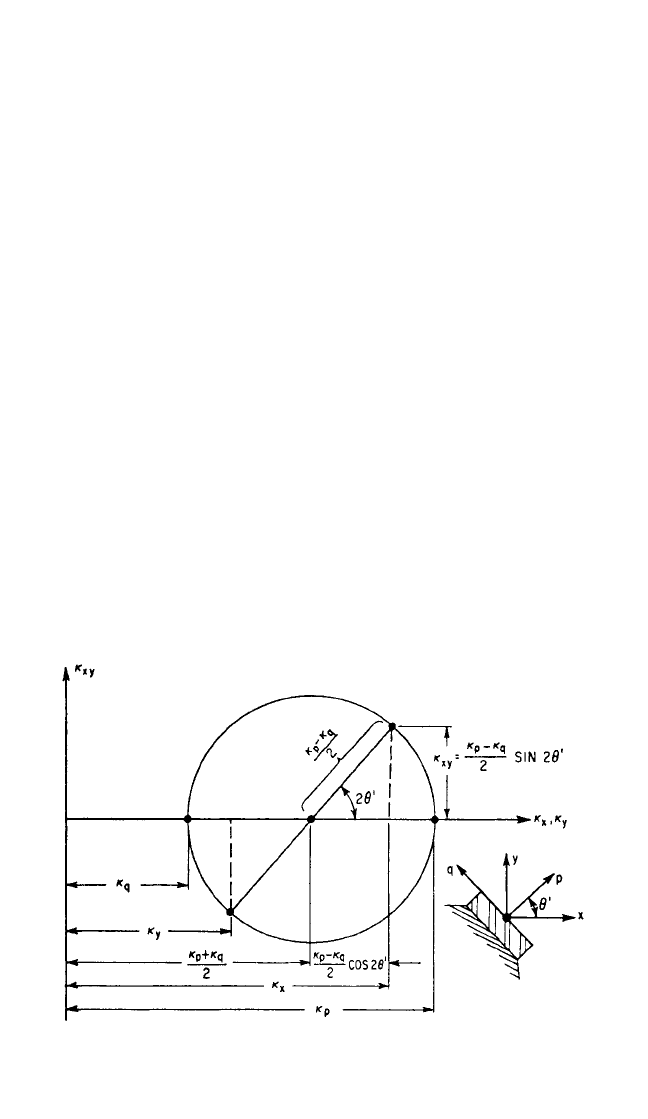Harris C.M., Piersol A.G. Harris Shock and vibration handbook
Подождите немного. Документ загружается.


INCLINED ISOLATORS
Advantages in vibration isolation sometimes result from inclining the principal elas-
tic axes of the isolators with respect to the principal inertia axes of the equipment, as
illustrated in Fig. 30.26. The coordinate axes X and Z are, respectively, parallel with
the principal inertia axes of the mounted body, but the center of coordinates is taken
at the elastic axis. The location of the
elastic axis is determined by the elastic
properties of the system. If a force is
applied to the body along a line extend-
ing through the elastic axis, the body is
displaced in translation without rota-
tion; if a couple is applied to the body,
the body is displaced in rotation without
translation.
The principal elastic axes r, p of the
isolators are parallel with the paper and
inclined with respect to the coordinate
axes, as indicated in Fig. 30.26. The stiff-
ness of each isolator in the direction of
the respective principal axis is indicated
by k
r
, k
p
. The principal elastic axis of an
isolator is the axis along which a force
must be applied to cause a deflection
colinear with the applied force (see the section Properties of a Biaxial Stiffness
Isolator).
Assume the excitation for the system shown in Fig. 30.26 to be a couple M
0
sin ωt
acting about an axis normal to the paper. The equations of motion for the body in
the horizontal translational and rotational modes may be written by noting that the
displacement of the center-of-gravity in the direction of the X axis is x − β; thus,
the corresponding acceleration is ¨x −
¨
β. A translational displacement x produces
only an external force −k
x
x, whereas a rotational displacement β produces only an
external couple −k
β
β. The equations of motion are
m(¨x −
¨
β) =−k
x
x
mρ
e
2
¨
β−m¨x =−k
β
β+M
0
sin ωt
(30.35)
where ρ
e
is the radius of gyration of the mounted body with respect to the elastic
axis. The radius of gyration ρ
e
is related to the radius of gyration ρ
y
with respect to a
line through the center-of-gravity by ρ
e
=
ρ
y
2
+
2
, where is the distance between
the elastic axis and a parallel line passing through the center-of-gravity. In the equa-
tions of motion, k
x
and k
β
represent the translational and rotational stiffness of the
isolators in the x and β coordinate directions, respectively.
By assuming steady-state harmonic motion for the horizontal translation x and
rotation β, the following displacement amplitudes are obtained by solving Eqs.
(30.35):
x
0
=
−M
0
ω
2
m[ρ
e
2
(ω
2
−ω
β
2
)(ω
2
−ω
x
2
) −
2
ω
4
]
THEORY OF VIBRATION ISOLATION 30.29
FIGURE 30.26 Schematic diagram of an
equipment supported by isolators whose princi-
pal elastic axes are inclined to the principal iner-
tia axes of the equipment.
8434_Harris_30_b.qxd 09/20/2001 11:41 AM Page 30.29

β
0
=
−M
0
(30.36)
m
ρ
e
2
(ω
2
−ω
β
2
) −
where ω
x
=
k
x
/
m
and ω
β
=
k
β
/
m
ρ
e
2
are hypothetical natural frequencies defined
for convenience. The natural frequencies ω
xβ
in the coupled x,β modes are deter-
mined by equating the denominator of Eqs. (30.36) to zero and solving for ω (now
identical to ω
xβ
):
=
(30.37)
where λ
1
is a dimensionless ratio given by
λ
1
= (30.38)
The hypothetical natural frequency ω
x
is
ω
x
=
cos
2
φ+ sin
2
φ
(30.39)
The relation given by Eq. (30.37) is shown graphically by Fig. 30.27. The parame-
ters needed to evaluate the natural fre-
quencies by using this graph are
calculated from the physical properties
of the system and the relations of Eqs.
(30.38) and (30.39). In addition, the dis-
tance between a parallel line passing
through the center-of-gravity and the
elastic axis must be known. The distance
is determined by effecting a small hori-
zontal displacement of the equipment in
the X direction and equating the result-
ing summation of elastic couples to zero:
= a
z
− (30.40)
where a
z
is the distance between the par-
allel planes passing through the center-
of-gravity of the body and the mid-height
of the isolators, as shown in Fig. 30.26.
DECOUPLING OF MODES
The natural modes of vibration of a
body supported by isolators may be
a
x
(1 − k
p
/k
r
) cot φ
(k
p
/k
r
) cot
2
φ+1
k
r
k
p
4k
p
m
(a
x
/ρ
e
)
k
r
/k
p
cos
2
φ+(k
r
/k
p
) sin
2
φ
1 +λ
1
2
±
(1
+
λ
1
2
)
2
−
4
λ
1
2
[1
−
(
/
ρ
e
)
2
]
2[1 − (/ρ
e
)
2
]
ω
xβ
ω
x
2
ω
4
ω
2
−ω
x
2
30.30 CHAPTER THIRTY
FIGURE 30.27 Curves indicating the natural
frequencies ω
xβ
in coupled modes with reference
to the natural frequency in the decoupled (ficti-
tious) horizontal translational mode ω
x
for the
system shown schematically in Fig. 30.26. The
radius of gyration with respect to the elastic axis
is indicated by ρ
e
, and the distance between the
center-of-gravity and the elastic center is .The
dimensionless parameter λ
1
is defined by Eq.
(30.38) and ω
x
is defined by Eq. (30.39).
8434_Harris_30_b.qxd 09/20/2001 11:41 AM Page 30.30

decoupled one from another by proper orientation of the isolators. Each mode of
vibration then exists independently of the others, and vibration in one mode does
not excite vibration in other modes.The necessary conditions for decoupling may be
stated as follows:The resultant of the forces applied to the mounted body by the iso-
lators when the mounted body is displaced in translation must be a force directed
through the center-of-gravity; or, the resultant of the couples applied to the mounted
body by the isolators when the mounted body is displaced in rotation must be a cou-
ple about an axis through the center-of-gravity.
In general, the natural frequencies of a multiple degree-of-freedom system can
be made equal only by decoupling the natural modes of vibration, i.e., by making
a
z
= 0 in Fig. 30.17. The natural frequencies in decoupled modes are indicated by the
two straight lines in Fig. 30.18 marked a
z
/ρ
y
= 0. The natural frequencies in transla-
tion along the X axis and in rotation about the Y axis become equal at the intersec-
tion of these lines; i.e., when a
z
/ρ
y
= 0, k
x
/k
z
= 1 and ρ
y
/a
x
= 1.The physical significance
of these mathematical conditions is that the isolators be located in a plane passing
through the center-of-gravity of the equipment, that the distance between isolators
be twice the radius of gyration of the equipment, and that the stiffness of each isola-
tor in the directions of the X and Z axes be equal.
When the isolators cannot be located in a plane which passes through the center-
of-gravity of the equipment, decoupling can be achieved by inclining the isolators, as
illustrated in Fig. 30.26. If the elastic axis of the system is made to pass through the
center-of-gravity, the translational and rotational modes are decoupled because the
inertia force of the mounted body is applied through the elastic center and intro-
duces no tendency for the body to rotate. The requirements for a decoupled system
are established by setting = 0 in Eq. (30.40) and solving for k
r
/k
p
:
= (30.41)
The conditions for decoupling defined by Eq. (30.41) are shown graphically in Figs.
30.28 and 3.23. The decoupled natural frequencies are indicated by the straight lines
/ρ
e
= 0 in Fig. 30.27.The horizontal line refers to the decoupled natural frequency ω
x
in translation in the direction of the X axis, while the inclined line refers to the
decoupled natural frequency ω
β
in rotation about the Y axis.
PROPERTIES OF A BIAXIAL STIFFNESS ISOLATOR
A biaxial stiffness isolator is represented as an elastic element having a single plane
of symmetry; all forces act in this plane and the resultant deflections are limited by
symmetry or constraints to this plane. The characteristic elastic properties of the iso-
lator may be defined alternatively by sets of influence coefficients as follows:
1. If the two coordinate axes in the plane of symmetry are selected arbitrarily, three
stiffness parameters are required to define the properties of the isolator. These
are the axial influence coefficients* along the two coordinate axes, and a charac-
teristic coupling influence coefficient* between the coordinate axes.
(a
x
/a
z
) + cot φ
(a
x
/a
z
) − tan φ
k
r
k
p
THEORY OF VIBRATION ISOLATION 30.31
* The influence coefficient κ is a function only of the isolator properties and not of the constraints
imposed by the system in which the isolator is used. Both positive and negative values of the influence coef-
ficient κ are permissible.
8434_Harris_30_b.qxd 09/20/2001 11:41 AM Page 30.31

2. If the two coordinate axes in the plane of symmetry are selected to coincide with
the principal elastic axes of the isolator, two influence coefficients are required to
define the properties of the isolator. These are the principal influence coeffi-
cients. If the isolator is used in a system, a third parameter is required to define
the orientation of the principal axes of the isolator with the coordinate axes of
the system.
PROPERTIES OF ISOLATOR WITH RESPECT
TO ARBITRARILY SELECTED AXES
A schematic representation of a linear biaxial stiffness element is shown in Fig. 30.29
where the X and Y axes are arbitrarily
chosen to define a plane to which all
forces and motions are restricted. In gen-
eral, the deflection of an isolator result-
ing from an applied load is not in the
same direction as the load, and a coupling
influence coefficient is required to define
the properties of the isolator in addition
to the influence coefficients along the X
and Y axes. The three characteristic stiff-
ness coefficients that uniquely describe
the load-deflection properties of a biaxial
stiffness element are:
1. The influence coefficient of the ele-
ment in the X coordinate direction is
κ
x
. It is the ratio of the component of
30.32 CHAPTER THIRTY
FIGURE 30.28 Ratio of stiffnesses k
r
/k
p
along principal elastic axes
required for decoupling the natural modes of vibration of the system illus-
trated in Fig. 30.26.
FIGURE 30.29 Schematic diagram of a linear
biaxial stiffness element.
8434_Harris_30_b.qxd 09/20/2001 11:41 AM Page 30.32

the applied force in the X direction to the resulting deflection when the isolator
is constrained to deflect in the X direction.
2. The influence coefficient of the element in the Y coordinate direction is κ
y
. It is
the ratio of the component of the applied force in the Y direction to the resulting
deflection when the isolator is constrained to deflect in the Y direction.
3. The coupling influence coefficient is κ
xy
. It represents the force required in the X
direction to produce a unit displacement in the Y direction when the isolator is
constrained to deflect only in the Y direction. (By Maxwell’s reciprocity princi-
ple, the same force is required in the Y direction to produce a unit displacement
in the X direction; i.e., κ
xy
=κ
yx
.)
Consider the isolator shown in Fig. 30.29 where the applied force F has compo-
nents F
x
and F
y
; the resulting displacement has components δ
x
and δ
y
. From the
above definitions of influence coefficients, the forces in the X and Y coordinate
directions required to effect a displacement δ
x
are
F
xx
=κ
x
δ
x
F
yx
=κ
yx
δ
x
(30.42)
The forces required to effect a displacement δ
y
in the Y direction are
F
xy
=κ
xy
δ
y
F
yy
=κ
y
δ
y
(30.43)
The force components F
x
and F
y
required to produce the deflection having compo-
nents δ
x
, δ
y
are the sums from Eqs. (30.42) and (30.43):
F
x
=κ
x
δ
x
+κ
xy
δ
y
(30.44)
F
y
=κ
yx
δ
x
+κ
y
δ
y
If the three influence stiffness coefficients κ
x
, κ
y
, and κ
xy
=κ
yx
are known for a given
stiffness element, the load-deflection properties are given by Eq. (30.44).
The deflections of the isolator in response to forces F
x
, F
y
are determined by solv-
ing Eqs. (30.44) simultaneously:
δ
x
=
δ
y
=
(30.45)
These expressions give the orthogonal components of the displacement δ for any
load having the components F
x
and F
y
applied to a biaxial stiffness isolator. By sub-
stituting the relations of Eqs. (30.45) into Eq. (30.44), the following alternate forms
of the force-deflection equations are obtained:
F
x
=
κ
x
−
δ
x
+ F
y
F
y
=
κ
y
−
δ
y
+ F
x
(30.46)
κ
xy
κ
x
κ
xy
2
κ
x
κ
xy
κ
y
κ
xy
2
κ
y
F
y
κ
x
− F
x
κ
xy
κ
x
κ
y
−κ
xy
2
F
x
κ
y
− F
y
κ
xy
κ
x
κ
y
−κ
xy
2
THEORY OF VIBRATION ISOLATION 30.33
8434_Harris_30_b.qxd 09/20/2001 11:41 AM Page 30.33

The specific force-deflection equations for a given situation are obtained from these
general load-deflection expressions by applying the proper constraint conditions.
Unconstrained Motion. The general force-deflection equations can be used to
obtain the effective stiffness coefficients when the forces F
x
and F
y
shown in Fig.
30.29 are applied independently. The resulting deflection of the isolator is uncon-
strained motion, i.e., the isolator is free to deflect out of the line of force application.
The force divided by that component of deflection along the line of action of the
force is the effective stiffness k. When F
y
= 0, the effective stiffness k
x
resulting from
the applied force F
x
is obtained from Eq. (30.46):
k
x
==
κ
x
−
(30.47)
When F
x
= 0, the effective stiffness k
y
in response to the applied force F
y
is
k
y
==
κ
y
−
(30.48)
For unconstrained motion, k
x
/k
y
=κ
x
/κ
y
; i.e., the ratio of the effective stiffnesses in
two mutually perpendicular directions is equal to the ratio of the corresponding
influence coefficients for the same directions.
Constrained Motion. When the isolator is constrained either by the symmetry of
a system or by structural constraints to deflect only along the line of the applied
force, the effective stiffness is obtained directly by letting appropriate deflections be
zero in Eq. (30.44):
k
x
==κ
x
k
y
==κ
y
(30.49)
The force required to maintain constrained motion is found by letting appropriate
deflections be zero in Eqs. (30.46). For example, the force that must be applied in the
X direction to ensure that the isolator deflects in the Y direction in response to a
force F
y
is
F
x
= F
y
(30.50)
INFLUENCE COEFFICIENT TRANSFORMATION
Assume the influence coefficients κ
x
, κ
y
, and κ
xy
are known in the X, Y coordinate
system. It may be convenient to work with isolator influence coefficients in the X′,
Y′ coordinate system as shown in Fig. 30.30.The X′, Y′ coordinate system is obtained
by rotating the coordinate axes counterclockwise through an angle θ from the X, Y
system. The influence coefficients with respect to the X′, Y′ axes are related to the
influence coefficients with respect to the X, Y axes as follows:
κ
x
′= + cos 2θ+κ
xy
sin 2θ
κ
x
−κ
y
2
κ
x
+κ
y
2
κ
xy
κ
y
F
y
δ
y
F
x
δ
x
κ
xy
2
κ
x
F
y
δ
y
κ
xy
2
κ
y
F
x
δ
x
30.34 CHAPTER THIRTY
8434_Harris_30_b.qxd 09/20/2001 11:41 AM Page 30.34

κ
x′y′
= sin 2θ+κ
xy
cos 2θ (30.51)
κ
y
′= − cos 2θ−κ
xy
sin 2θ
The influence coefficient transformation of a biaxial stiffness isolator from one set of
arbitrarily chosen coordinate axes to another arbitrarily chosen set of coordinate axes
is described by the two-dimensional Mohr circle.
7
Since the influence coefficient is a
tensor quantity, the following invariants of the influence coefficient tensor give addi-
tional relations between the influence coefficients in the X,Y and the X′, Y′ set of axes:
κ
x
+κ
y
=κ
x′
+κ
y′
κ
x
κ
y
−κ
xy
2
=κ
x′
κ
y′
−κ
x′y′
2
(30.52)
PRINCIPAL INFLUENCE COEFFICIENTS
The set of axes for which there exists no coupling influence coefficient are the prin-
cipal axes of stiffness (principal elastic axes). These axes can be found by requiring
κ
x′y′
to be zero in Eq. (30.51) and solving for the rotation angle corresponding to this
condition. Letting θ′ represent the angle of rotation for which κ
x′y′
= 0:
tan 2θ′ = (30.53)
By substituting this value of the angle of rotation into the general influence coeffi-
cient expressions, Eqs. (30.51), the following relation is obtained for the principal
influence coefficients:
κ
p
, κ
q
=±
2
+κ
xy
2
(30.54)
where p and q represent the principal axes of stiffness. The principal influence coef-
ficients are the maximum and minimum influence coefficients that exist for a linear
κ
x
−κ
y
2
κ
x
+κ
y
2
2κ
xy
κ
x
−κ
y
κ
x
−κ
y
2
κ
x
+κ
y
2
κ
y
−κ
x
2
THEORY OF VIBRATION ISOLATION 30.35
FIGURE 30.30 (A) Force and (B) displacement transformation dia-
grams for a linear biaxial stiffness element.
8434_Harris_30_b.qxd 09/20/2001 11:41 AM Page 30.35

biaxial stiffness isolator. In Eq. (30.54), the plus sign gives the maximum influence
coefficient whereas the minus sign gives the minimum influence coefficient. Either
κ
p
or κ
q
can be the maximum influence coefficient, depending on the degree of axis
rotation and the relative values of κ
x
, κ
y
, and κ
xy
.
INFLUENCE COEFFICIENT TRANSFORMATION
FROM THE PRINCIPAL AXES
The influence coefficient transformation from the principal axes p, q is of practical
interest. The influence coefficients in the XY frame of reference are determined
from Eq. (30.51) by setting κ
x′y′
=κ
pq
= 0, κ
x
′=κ
p
, κ
y′
=κ
q
, and θ=θ′. The influence
coefficients in the XY frame-of-reference may be expressed in terms of the principal
influence coefficients as follows:
κ
x
=κ
p
cos
2
θ′ + κ
q
sin
2
θ′ = + cos 2θ′
κ
xy
= (κ
p
−κ
q
) sin θ′ cos θ′ = sin 2θ′ (30.55)
κ
y
=κ
p
sin
2
θ′ + κ
q
cos
2
θ′ = − cos 2θ′
The transformation from the principal axes in the form of a two-dimensional Mohr’s
circle is shown by Fig. 30.31. This circle provides quick graphical determination of
κ
p
−κ
q
2
κ
p
+κ
q
2
κ
p
−κ
q
2
κ
p
−κ
q
2
κ
p
+κ
q
2
30.36 CHAPTER THIRTY
FIGURE 30.31 Mohr-circle representation of the stiffness transformation from
the principal axes of stiffness of a biaxial stiffness element. The p, q axes represent
the principal stiffness axes and the X,Y axes are any arbitrary set of axes separated
from the p, q axes by a rotation angle θ′.
8434_Harris_30_b.qxd 09/20/2001 11:41 AM Page 30.36

the three influence coefficients κ
x
, κ
y
, and κ
xy
for any angle θ′ between the P and X
axes, where θ′ is positive in the sense shown in the inset to Fig. 30.31.
Example 30.2. Consider the system shown schematically by Fig. 30.26. The
transformation theory for the influence coefficient of a biaxial stiffness element may
be applied to develop the effective stiffness coefficients for this system. The center
of coordinates for the XZ axes is at the elastic center of the system. The principal
elastic axes of the isolators p, r are oriented at an angle φ with the coordinate axes X,
Z, respectively.* The position of the elastic center is determined by effecting a small
horizontal displacement δ
x
of the body, letting δ
z
be zero and equating the summa-
tion of couples resulting from the isolator forces. The forces F
x
and F
z
are deter-
mined from Eqs. (30.44):
F
x
=κ
x
δ
x
=κ
x
δ
x
F
z
=κ
zx
δ
x
=κ
zx
δ
x
Each of the forces F
x
acts at a distance −a
ze
from the elastic center; the force F
z
at the
right-hand isolator is positive and acts at a distance a
x
from the elastic center
whereas the force F
z
at the left-hand isolator is negative and acts at a distance −a
x
from the elastic center.Taking a summation of the moments:
−2a
ze
F
x
+ 2a
x
F
z
= 0
Substituting the above relations between the forces F
x
, F
z
and the influence coeffi-
cients κ
z
, κ
zz
into Eqs. (30.55), and noting that θ′ = 90°−φ(compare Figs. 30.30 and
30.26), the following result is obtained in terms of principal stiffnesses:
== =
Substituting = a
z
− a
ze
in the preceding equation, the relation for given by Eq.
(30.40) is obtained.
Since the equations of motion are written in a coordinate system passing through
the elastic center, all displacements in this frame-of-reference are constrained.
Therefore, the effective stiffness coefficients for a single isolator may be obtained
from Eq. (30.55) as follows [see Eq. (30.49)]:
k
x
=κ
x
= k
r
sin
2
φ+k
p
cos
2
φ
k
z
=κ
z
= k
r
cos
2
φ+k
p
sin
2
φ
These effective stiffness coefficients define the hypothetical natural frequency ω
x
given by Eq. (30.39) as well as the uncoupled vertical natural frequency ω
z
. Since
four isolators are used in the problem represented by Fig. 30.26, the translational
stiffnesses given by the above expressions for k
x
and k
z
must be multiplied by 4 to
obtain the total translational stiffness.
The effective rotational stiffness of a single isolator k
β
can be obtained by deter-
mining the sum of the restoring moments for a constrained rotation β. When the
body is rotated through an angle β, the displacements at the right isolator are
δ
x
=−a
ze
β and δ
z
= a
x
β, where a
ze
is a negative distance since it is measured in the neg-
ative Z direction.The sum of the restoring moments is (F
z
a
x
− F
x
a
ze
), where F
x
and F
z
(k
r
− k
p
) sin φ cos φ
k
r
sin
2
φ+k
p
cos
2
φ
κ
zx
κ
x
F
z
F
x
a
ze
a
x
THEORY OF VIBRATION ISOLATION 30.37
* The properties of a biaxial stiffness element may be defined with respect to any pair of coordinate axes.
In Fig. 30.26, the principal elastic axis q is parallel with the coordinate axis Y; then the analysis considers the
principal elastic axes p, r which lie in the plane defined by the XZ coordinate axes.
8434_Harris_30_b.qxd 09/20/2001 11:41 AM Page 30.37

are the forces acting on the right isolator in Fig. 30.26. The forces F
x
and F
z
may be
written in terms of the influence coefficients and the displacements δ
x
and δ
z
by use
of Eq. (30.44) to produce the following moment equation:
M
β
= k
β
β=β[k
x
a
ze
2
− 2k
xz
a
ze
a
x
+ k
z
a
x
2
]
where the effective rotational stiffness k
β
of a single isolator is
k
β
= k
x
a
2
− 2k
xz
a
ze
a
x
+ k
z
a
x
2
The distance a
ze
can be eliminated from the expression for rotational stiffness by sub-
stituting a
ze
= a
x
F
z
/F
x
obtained from the summation of couples about the elastic center:
k
β
= a
x
2
The numerator of this expression can be replaced by k
r
k
p
[see Eq. (30.52)] where the
r, p axes are the principal elastic axes of the isolator and k
rp
= 0. Also, k
x
can be
replaced by its equivalent form given by Eq. (30.55). Making these substitutions, the
effective rotational stiffness for one isolator in terms of the principal stiffness coef-
ficients of the isolator becomes
k
β
=
Since four isolators are used in the problem represented by Fig. 30.26, the rotational
stiffness given by the above expression for k
β
must be multiplied by 4 to obtain the
total rotational stiffness of the system.
NONLINEAR VIBRATION ISOLATORS
In vibration isolation, the vibration amplitudes generally are small and linear vibra-
tion theory usually is applicable with sufficient accuracy.* However, the static effects
of nonlinearity should be considered. Even though a nonlinear isolator may have
approximately constant stiffness for small incremental deflections, the nonlinearity
becomes important when large deflections of the isolator occur due to the effects of
equipment weight and sustained acceleration. A vibration isolator often exhibits a
stiffness that increases with applied force or deflection. Such a nonlinear stiffness is
characteristic, for example, of rubber in compression or a conical spring.
In Eq. (30.11) for natural frequency, the stiffness k for a linear stiffness element is
a constant. However, for a nonlinear isolator, the stiffness k is the slope of the force-
deflection curve and Eq. (30.11) may be written
ω
n
= 2πf
n
=
(30.56)
where W is the total weight supported by the isolator, g is the acceleration of grav-
ity, and dF/dδ is the slope of the line tangent to the force-deflection curve at the
static equilibrium position.Vibration is considered to be small variations in the posi-
g(dF/dδ)
W
a
x
2
k
p
sin
2
φ+(k
p
/k
r
) cos
2
φ
k
x
k
z
− k
xz
2
k
x
30.38 CHAPTER THIRTY
* If the vibration amplitude is large, nonlinear vibration theory as discussed in Chap. 4 is applicable.
8434_Harris_30_b.qxd 09/20/2001 11:41 AM Page 30.38
